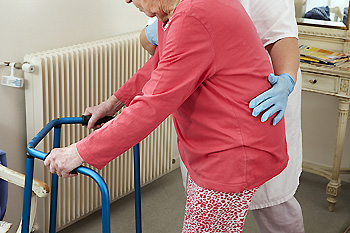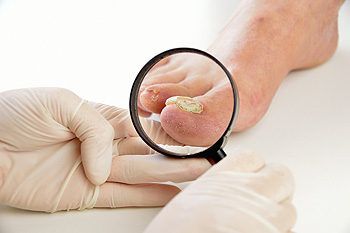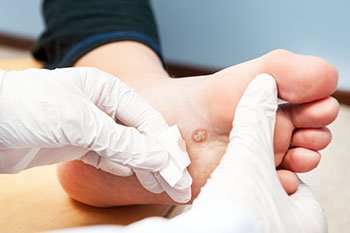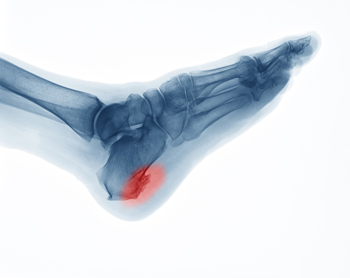July 2021
How and Where Plantar Warts Occur
When the outer layer of skin on the sole of the feet comes in contact with the human papilloma virus, thickened growths called plantar warts can develop. The virus—which can lurk in public showers, pools, and locker rooms—enters through tiny breaks in the skin on the bottom of feet. These flat, rough masses sometimes have tiny black “dots” in the center, which are actually tiny blood vessels. They can be uncomfortable at times—especially if they occur on weight-bearing areas of the feet and toes. While verrucas can often heal on their own, they can be stubborn, and you may want to see a podiatrist to help get rid of them.
Plantar warts can be very uncomfortable. If you need your feet checked, contact one of our podiatrists from Advanced Foot & Ankle Associates, PLLC. Our doctors will assist you with all of your foot and ankle needs.
About Plantar Warts
Plantar warts are the result of HPV, or human papillomavirus, getting into open wounds on the feet. They are mostly found on the heels or balls of the feet.
While plantar warts are generally harmless, those experiencing excessive pain or those suffering from diabetes or a compromised immune system require immediate medical care. Plantar warts are easily diagnosed, usually through scraping off a bit of rough skin or by getting a biopsy.
Symptoms
- Lesions on the bottom of your feet, usually rough and grainy
- Hard or thick callused spots
- Wart seeds, which are small clotted blood vessels that look like little black spots
- Pain, discomfort, or tenderness of your feet when walking or standing
Treatment
- Freezing
- Electric tool removal
- Laser Treatment
- Topical Creams (prescription only)
- Over-the-counter medications
To help prevent developing plantar warts, avoid walking barefoot over abrasive surfaces that can cause cuts or wounds for HPV to get into. Avoiding direct contact with other warts, as well as not picking or rubbing existing warts, can help prevent the further spread of plantar warts. However, if you think you have developed plantar warts, speak to your podiatrist. He or she can diagnose the warts on your feet and recommend the appropriate treatment options.
If you have any questions please feel free to contact one of our offices located in Lake Worth and Aledo/Willow Park, TX . We offer the newest diagnostic and treatment technologies for all your foot and ankle needs.
Heel Pain Can Be Treated!
Can Falling Be Prevented?
 Seniors may be more prone to falling for several reasons. These can consist of diminished eyesight, lack of balance, and vitamin deficiencies. Falling one time can double the chances of falling again. There are methods that can be implemented which may help to prevent falling. These include removing worn rugs from the living environment, and installing grab bars in the shower and toilet areas. Additionally, it is beneficial to use a bathmat, as this can provide stability while bathing or showering. It is helpful to have regular physical examinations so that existing medications can be reviewed. Certain medications can negatively impact balance and coordination, making falling more likely. Falling can seriously affect the feet, causing injuries such as ankle sprains and fractures. If you would like more information about the effects of falling on the feet, and possible ways to prevent falling episodes, please speak with a podiatrist.
Seniors may be more prone to falling for several reasons. These can consist of diminished eyesight, lack of balance, and vitamin deficiencies. Falling one time can double the chances of falling again. There are methods that can be implemented which may help to prevent falling. These include removing worn rugs from the living environment, and installing grab bars in the shower and toilet areas. Additionally, it is beneficial to use a bathmat, as this can provide stability while bathing or showering. It is helpful to have regular physical examinations so that existing medications can be reviewed. Certain medications can negatively impact balance and coordination, making falling more likely. Falling can seriously affect the feet, causing injuries such as ankle sprains and fractures. If you would like more information about the effects of falling on the feet, and possible ways to prevent falling episodes, please speak with a podiatrist.
Preventing falls among the elderly is very important. If you are older and have fallen or fear that you are prone to falling, consult with one of our podiatrists from Advanced Foot & Ankle Associates, PLLC. Our doctors will assess your condition and provide you with quality advice and care.
Every 11 seconds, an elderly American is being treated in an emergency room for a fall related injury. Falls are the leading cause of head and hip injuries for those 65 and older. Due to decreases in strength, balance, senses, and lack of awareness, elderly persons are very susceptible to falling. Thankfully, there are a number of things older persons can do to prevent falls.
How to Prevent Falls
Some effective methods that older persons can do to prevent falls include:
- Enrolling in strength and balance exercise program to increase balance and strength
- Periodically having your sight and hearing checked
- Discuss any medications you have with a doctor to see if it increases the risk of falling
- Clearing the house of falling hazards and installing devices like grab bars and railings
- Utilizing a walker or cane
- Wearing shoes that provide good support and cushioning
- Talking to family members about falling and increasing awareness
Falling can be a traumatic and embarrassing experience for elderly persons; this can make them less willing to leave the house, and less willing to talk to someone about their fears of falling. Doing such things, however, will increase the likelihood of tripping or losing one’s balance. Knowing the causes of falling and how to prevent them is the best way to mitigate the risk of serious injury.
If you have any questions, please feel free to contact one of our offices located in Lake Worth and Aledo/Willow Park, TX . We offer the newest diagnostic and treatment technologies for all your foot care needs.
Are Heel Spurs Problematic?
Heel spurs are bony growths that develop around the heel bone, typically in response to injury over time. On their own, heel spurs are thought to be asymptomatic. Often, people only know they have a heel spur because it was found incidentally on an X-ray. Nevertheless, while they are not as likely to cause pain on their own, heel spurs are associated with certain painful foot conditions, such as plantar fasciitis. If you are experiencing heel pain, it is suggested that you see a podiatrist. This medical professional can diagnose your heel pain and offer effective treatments to relieve your symptoms.
Heel spurs can be incredibly painful and sometimes may make you unable to participate in physical activities. To get medical care for your heel spurs, contact one of our podiatrists from Advanced Foot & Ankle Associates, PLLC. Our doctors will do everything possible to treat your condition.
Heels Spurs
Heel spurs are formed by calcium deposits on the back of the foot where the heel is. This can also be caused by small fragments of bone breaking off one section of the foot, attaching onto the back of the foot. Heel spurs can also be bone growth on the back of the foot and may grow in the direction of the arch of the foot.
Older individuals usually suffer from heel spurs and pain sometimes intensifies with age. One of the main condition's spurs are related to is plantar fasciitis.
Pain
The pain associated with spurs is often because of weight placed on the feet. When someone is walking, their entire weight is concentrated on the feet. Bone spurs then have the tendency to affect other bones and tissues around the foot. As the pain continues, the feet will become tender and sensitive over time.
Treatments
There are many ways to treat heel spurs. If one is suffering from heel spurs in conjunction with pain, there are several methods for healing. Medication, surgery, and herbal care are some options.
If you have any questions feel free to contact one of our offices located in Lake Worth and Aledo/Willow Park, TX . We offer the latest in diagnostic and treatment technology to meet your needs.
Am I at Risk for Toenail Fungus?
 Onychomycosis is a contagious fungal infection of the toenails. Infected nails may appear discolored, thickened, brittle, and crumbly. Onychomycosis often affects the big and little toenails, but can affect any nail. Certain people are more at risk of contracting a fungal toenail infection than others. Since the fungus responsible for toenail infections thrives in warm and moist environments, those who live in hot, humid climates, sweat excessively, wear shoes and socks with poor ventilation, experience prolonged exposure to water, or frequent areas like public swimming pools and locker rooms, are more likely to incur an infection. People who are older or have underlying health conditions, such as diabetes or psoriasis, are also at an increased risk. Having certain pre-existing foot problems, including athlete’s foot, a fungal skin infection of the feet, or a previous toenail injury can also make you more susceptible to a fungal nail infection. If you suspect that you may have onychomycosis, please seek the care of a podiatrist.
Onychomycosis is a contagious fungal infection of the toenails. Infected nails may appear discolored, thickened, brittle, and crumbly. Onychomycosis often affects the big and little toenails, but can affect any nail. Certain people are more at risk of contracting a fungal toenail infection than others. Since the fungus responsible for toenail infections thrives in warm and moist environments, those who live in hot, humid climates, sweat excessively, wear shoes and socks with poor ventilation, experience prolonged exposure to water, or frequent areas like public swimming pools and locker rooms, are more likely to incur an infection. People who are older or have underlying health conditions, such as diabetes or psoriasis, are also at an increased risk. Having certain pre-existing foot problems, including athlete’s foot, a fungal skin infection of the feet, or a previous toenail injury can also make you more susceptible to a fungal nail infection. If you suspect that you may have onychomycosis, please seek the care of a podiatrist.
If left untreated, toenail fungus may spread to other toenails, skin, or even fingernails. If you suspect you have toenail fungus it is important to seek treatment right away. For more information about treatment, contact one of our podiatrists of Advanced Foot & Ankle Associates, PLLC. Our doctors can provide the care you need to keep you pain-free and on your feet.
Symptoms
- Warped or oddly shaped nails
- Yellowish nails
- Loose/separated nail
- Buildup of bits and pieces of nail fragments under the nail
- Brittle, broken, thickened nail
Treatment
If self-care strategies and over-the-counter medications does not help your fungus, your podiatrist may give you a prescription drug instead. Even if you find relief from your toenail fungus symptoms, you may experience a repeat infection in the future.
Prevention
In order to prevent getting toenail fungus in the future, you should always make sure to wash your feet with soap and water. After washing, it is important to dry your feet thoroughly especially in between the toes. When trimming your toenails, be sure to trim straight across instead of in a rounded shape. It is crucial not to cover up discolored nails with nail polish because that will prevent your nail from being able to “breathe”.
In some cases, surgical procedure may be needed to remove the toenail fungus. Consult with your podiatrist about the best treatment options for your case of toenail fungus.
If you have any questions, please feel free to contact one of our offices located in Lake Worth and Aledo/Willow Park, TX . We offer the newest diagnostic and treatment technologies for all your foot care needs.
Blog Archives
- April 2025
- March 2025
- February 2025
- January 2025
- December 2024
- November 2024
- October 2024
- September 2024
- August 2024
- July 2024
- June 2024
- May 2024
- April 2024
- March 2024
- February 2024
- January 2024
- December 2023
- November 2023
- October 2023
- September 2023
- August 2023
- July 2023
- June 2023
- May 2023
- April 2023
- March 2023
- February 2023
- January 2023
- December 2022
- November 2022
- October 2022
- September 2022
- August 2022
- July 2022
- June 2022
- May 2022
- April 2022
- March 2022
- February 2022
- January 2022
- December 2021
- November 2021
- October 2021
- September 2021
- August 2021
- July 2021
- June 2021
- May 2021
- April 2021
- March 2021
- February 2021
- January 2021
- December 2020
- November 2020
- October 2020
- September 2020
- August 2020
- July 2020
- June 2020
- May 2020
- April 2020
- March 2020
- February 2020
- January 2020
- December 2019
- November 2019
- October 2019
- September 2019
- August 2019
- July 2019
- June 2019
- May 2019
- April 2019
- March 2019
- February 2019
- January 2019
- December 2018
- November 2018
- October 2018







